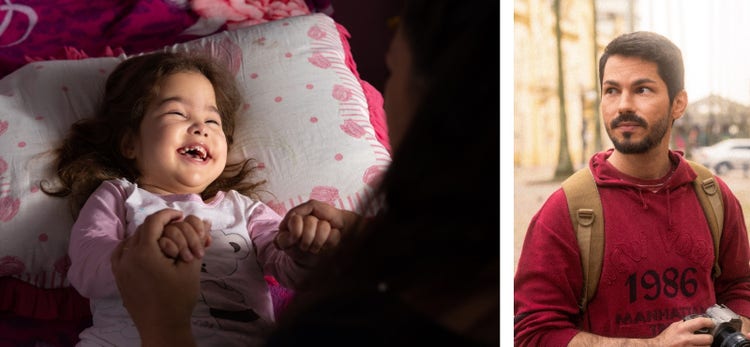Adobe Stock artist Gabriel Vergani on creating authentic portraits of people with disabilities

Image credit: Adobe Stock / Gabriel Vergani.
Drawn to photography for as long as he can remember, Adobe Stock Contributor Gabriel Vergani says the following bit of advice has always resonated with him: You should choose one thing that captivates you, and then spend your life and career pursuing it.
Born in the Butantã neighborhood of São Paulo, Brazil, Vergani initially turned his passion for photography into a career in his family’s business in the tourism industry. When he got his first paycheck at the age of 19, he bought a digital camera.
Soon after, his work caught the attention of judges in a photography contest, and that gave him the motivation he needed to pursue photography full-time. He began taking courses to improve his technique and discovered a love for photographing architecture. Now, he shoots photos for hotels, offices, and restaurants in addition to stock photography.
“Architectural photography involves taking the time to think and work the image slowly to build a result,” he says. “This slower approach allows me to be very connected to the photograph. I really enjoy the planning involved in producing an image of that nature, understanding positioning and light.”
When it comes to shooting portraits, Vergani tries to create images with a lot of warmth — a feeling he equates with his Brazilian upbringing. He likes to create photos of people smiling, hugging, touching, being close to one another, showing affection, and interacting together.
“I’m really trying to represent Brazilian culture,” he says. “I like to shoot in groups, to show people getting together and having fun. The end products are always incredibly dynamic photos. I don't know if it's my Brazilian heritage, but I believe that this is due to Brazilian comfort and hospitality.”

Image credit: Adobe Stock / Gabriel Vergani, courtesy Gabriel Vergani.
Creating portraits of people with disabilities
“I really appreciate and enjoy capturing diversity on film,” Vergani says. “It was on my radar to start photographing people with disabilities in a positive way that shows who they uniquely are.”
When approaching the creative brief, Vergani wanted to expand on the idea of diversity in the disability community, adding layers of representation not only through the visual expression of different bodies, but through regional casting that reflects the broad demographics of people with disabilities.
Stock imagery depicting people with disabilities is often skewed toward Caucasians, even though disabilities are present across races and ethnicities. More than 1 billion people have a disability, yet less than 3 percent of characters on North American television are people with disabilities. Often, those few characters are portrayed by actors without disabilities. It’s clear that the world needs more representation of people with disabilities, and that representation needs to be more accurate.
“Adobe gave me full flexibility in how I wanted to take these photographs in my own style,” Vergani says. “I was trying to bring in as many people as possible from different backgrounds, ages, and ethnicities to portray different activities.”
During the process, he grew to understand more about how to work with people with disabilities and how to create the best environment for everyone involved.
For example, he says, a couple who participated in one of his photo shoots shared eye-opening insights. Both wheelchair users, they told him that many stock images depict people in generic wheelchairs that are used only to transport patients outside of hospitals. They explained that they and other regular wheelchair users get around in wheelchairs that are much smaller than these generic types. They also explained that while stock photos often depict people in wheelchairs being pushed by others, many wheelchair users prefer to perform these tasks on their own, without help.
Vergani says this kind of nuance is easily lost when stock photos of people with disabilities feature models without disabilities using props rather than people with disabilities, in real situations, with the real equipment they use every day.

Image credit: Adobe Stock / Gabriel Vergani, Adobe Stock / Gabriel Vergani.
Portraying people just as they are
Despite all his research and prep work, Vergani still experienced a few revelations during his photo shoots.
“I still feel I need to let go of some misconceptions and points of view,” Vergani says. “Like during the shoot, I was asking the models to ‘point the wheelchair’ in a specific direction.” He realized he was making the mistake of focusing on the wheelchair, but not the person in it.
There is a sensitivity in Vergani’s portrait work that comes not only from his photography talents, but from his openness to understanding and capturing people’s stories.
“One of the models I photographed has a specific disability that limits her life expectancy,” he says. “The shoot ultimately turned out to be a way of visually recording her life for her mother, a much more ephemeral moment that went beyond capturing commercial content. I was very touched by it.” During another photo shoot, with a basketball player in a wheelchair on a court near his house, the subject quietly pointed out the place where he had the accident that had left him paralyzed.
“The people I photograph aren’t simply models — they’re real people with real lives and stories,” Vergani says. “The shoot is a construction. I do half the work, framing the environment, the light, subject — but it’s the model who will deliver the emotion to the image. I ask all models to put themselves in the photos, show themselves exactly as they are.”
Vergani hopes that stock photography like his will bring greater visibility to the way that people are more alike than different.